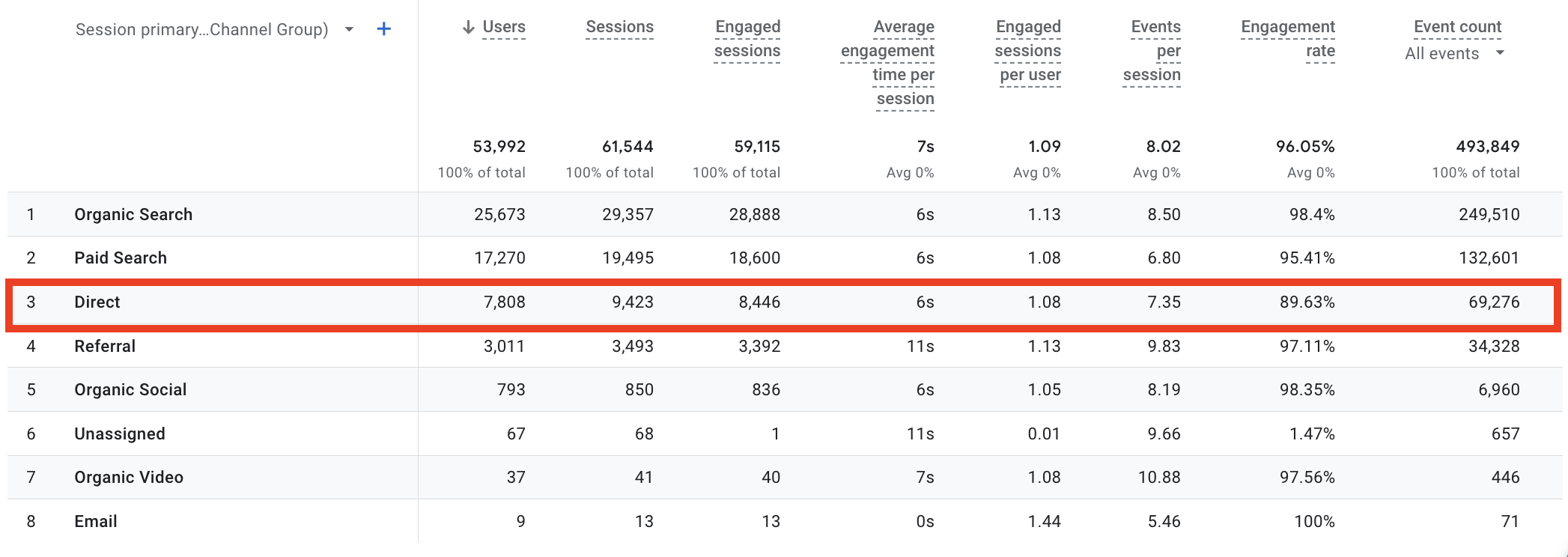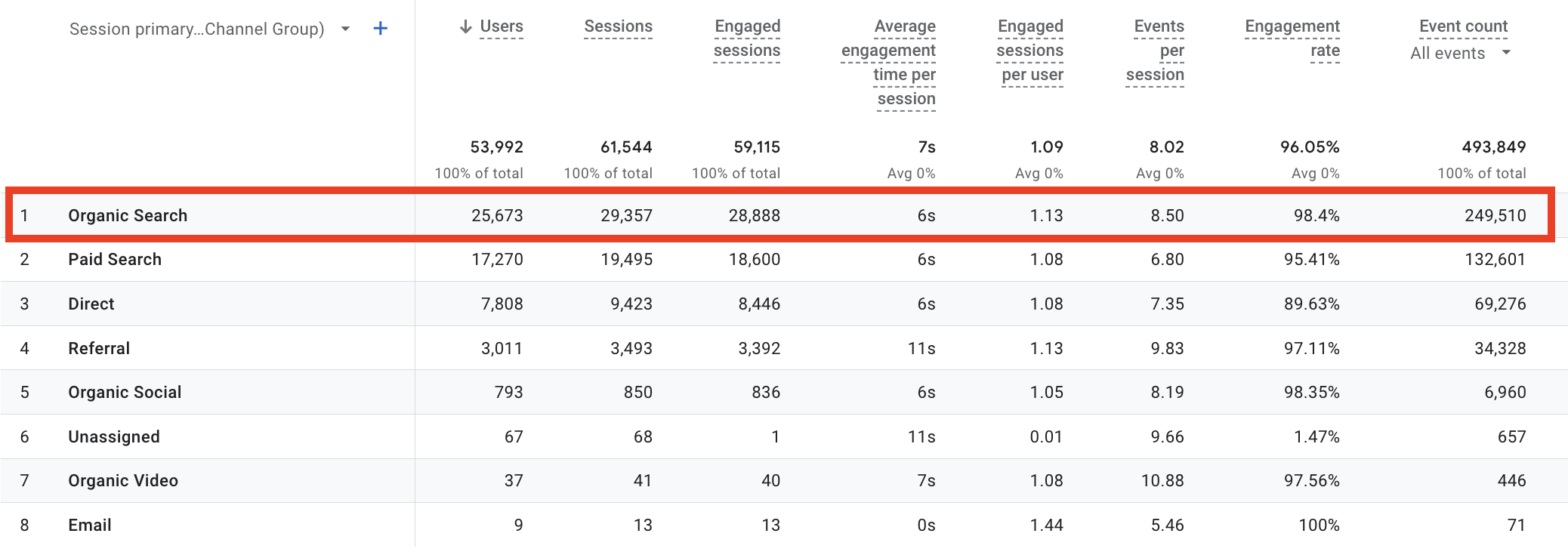The lifeblood of any online business is website traffic, but not all traffic is created equal. If you’ve ever analyzed your website data, you’ve probably noticed two main traffic sources standing out: direct vs organic traffic. Understanding the differences between direct vs organic traffic can be the key to unlocking your website’s full potential.
Ever wondered why some visitors land directly on your website while others arrive through search engines? This distinction isn’t just a trivial detail—it’s a critical factor that influences your overall digital marketing strategy. Direct traffic often signifies brand loyalty, a direct connection between your audience and your brand. On the other hand, organic traffic reflects the effectiveness of your SEO efforts, drawing in users who are actively searching for the solutions you offer.
Consider this: on average, direct traffic accounts for 22% of all website traffic, while organic search drives 17%, making them the two most prominent sources of website traffic (HubSpot). This distribution highlights the importance of both sources in driving your website’s success. By understanding and optimizing for each type, you can maximize engagement, conversions, and ultimately, revenue.
The first step to mastering your digital marketing strategy is understanding these traffic sources. This blog post will demystify the nuances between direct vs organic traffic, helping you harness each with proven strategies. Whether you’re a marketer or a business owner trying to get a grip on your web analytics, your journey to becoming traffic-savvy starts here!
Direct vs Organic Traffic: Why it Matters
Direct and organic traffic drive visitors to your website differently, affecting your user engagement and conversion rates. Differentiating between them enables you to tailor strategies that maximize their benefits and optimize your overall digital presence.
Direct Traffic: Direct traffic is a strong indicator of brand loyalty and recognition. Visitors who come directly to your site usually do so by typing your URL into their browser, using bookmarks, or clicking on links from non-trackable sources like offline media or certain email campaigns. This type of traffic often includes repeat visitors who are already familiar with your brand, suggesting a higher likelihood of engagement and conversion.
Organic Traffic: Organic traffic, on the other hand, is a testament to your SEO efforts. These visitors find your website through search engines, driven by the keywords and content you’ve optimized for. Organic traffic can introduce your site to new users actively seeking information, products, or services you offer. This traffic source is crucial for long-term growth and sustainability as it relies on the visibility and relevance of your content in search engine results.
Understanding where your traffic comes from helps in resource allocation and strategic planning. Direct traffic often reflects the effectiveness of your offline marketing efforts and brand strength, while organic traffic highlights the success of your SEO strategies. By analyzing these two sources, you can:
- Optimize Marketing Spend: Allocate resources effectively between brand-building activities and SEO strategies.
- Enhance User Engagement: Tailor content and experiences based on the type of traffic to improve engagement and conversion rates.
- Identify Growth Opportunities: Recognize which areas need more focus, whether it’s strengthening your brand to boost direct traffic or enhancing SEO efforts to increase organic traffic.
By mastering the art of balancing direct vs organic traffic, you can create a more robust and effective digital marketing strategy that drives sustained growth and success.

What is Direct Traffic?
Direct traffic is all about the visitors who reach your website without any intermediary referring site. This happens when users type your URL directly into their browser. Direct traffic is a strong indicator of brand recognition and loyalty, as these visitors are often repeat users who are familiar with your business.
Common Sources of Direct Traffic:
- Typed-in URLs: Users manually entering your website address.
- Bookmarks: Visitors saving your site for easy access later.
- Untracked Email Links: Links in emails that don’t include tracking parameters.
- Offline Marketing Efforts: Printed materials, TV ads, or word-of-mouth where users are told about your URL.
Direct traffic is crucial because it often includes high-intent visitors who are more likely to engage with your content, make purchases, or return for future visits. Monitoring direct traffic helps you understand the effectiveness of your offline marketing efforts and the strength of your brand loyalty.
What is Organic Traffic?
Organic traffic comes from users finding your website through search engines like Google, Bing, or Yahoo. These visitors arrive at your site by entering search queries and clicking on your link in the search engine results pages (SERPs). Organic traffic is predominantly driven by SEO efforts, aiming to improve your site’s visibility and ranking for relevant keywords.
How Organic Traffic is Tracked:
- Search Engines: Users performing keyword searches that lead them to your website.
- SEO Efforts: Content optimization, keyword targeting, and link-building strategies to improve search rankings.
- SERPs Visibility: High rankings on search engine results pages leading to more clicks and visits.
Organic traffic is valuable because it brings in users who are actively seeking information, products, or services that you offer. This type of traffic is typically high-quality and can result in higher engagement and conversion rates. By investing in SEO, you can attract a steady stream of organic traffic, which is essential for long-term growth and sustainability.
Direct vs Organic Search: Key Differences
When comparing direct vs organic search, the primary differences lie in how visitors find your site and their intent upon arrival.
Direct Traffic: These visitors reach your site by typing your URL directly into their browser, using bookmarks, or clicking on links from untracked sources. They often represent repeat users or those with strong brand recognition.
Organic Traffic: These visitors find your site through search engines like Google, driven by keyword searches. Their intent is often more exploratory, seeking specific information or solutions that match their search queries.
Key Differences:
- User Intent: Direct traffic users have a specific goal and familiarity with your brand, leading to higher engagement. Organic traffic users are typically in the discovery phase.
- Behavior: Direct traffic usually has lower bounce rates and higher conversion rates due to user familiarity. Organic traffic may vary in engagement based on how well your site matches their search intent.
- Acquisition Source: Direct traffic comes from known, non-tracked sources, while organic traffic is generated through SEO efforts and search engine visibility.

Comparing the Benefits of Organic vs Direct Traffic
Both direct and organic traffic offer unique advantages that can significantly impact your website’s performance. Let’s break down these benefits to see how each type of traffic can contribute to your overall digital marketing success.
Direct Traffic Benefits
One of the standout benefits of direct traffic is higher engagement. Visitors who come directly to your site are often familiar with your brand. They’re likely typing in your URL or using bookmarks, indicating a level of trust and recognition that drives them to return. This familiarity often translates into lower bounce rates and higher conversion rates because these users know what they want and believe your site will deliver.
Direct traffic also indicates strong brand loyalty. These are your repeat visitors, the ones who have engaged with your content, products, or services before and found value. They come back because they know and trust your brand, which is a powerful testament to your business’s reputation.
Organic Traffic Benefits
On the flip side, organic traffic brings its own set of valuable benefits. First and foremost is cost-effectiveness. Unlike paid ads, organic traffic doesn’t incur a cost per click. Instead, it’s driven by your SEO efforts, making it a sustainable way to attract visitors over time.
Organic traffic also tends to be highly relevant. These visitors are actively searching for information, products, or services that match your offerings. They’re using search engines with specific queries, and if your SEO strategy is effective, your site appears as the answer to their questions. Organic traffic often signifies users who are actively searching for a solution and find your content to meet that need, which may result in more focused engagement (Shopify). This relevance often results in higher engagement and better conversion rates as these users find exactly what they’re looking for on your site.
Moreover, organic traffic contributes to sustained growth. With continuous SEO efforts, your site can maintain or improve its position on search engine results pages (SERPs). This visibility ensures a steady stream of visitors who find your content valuable and relevant, leading to consistent traffic growth and long-term success.
How to Find Direct Traffic in Google Analytics
Understanding your direct traffic is crucial for assessing your brand’s strength and the effectiveness of your offline marketing efforts. Here’s a step-by-step guide on how to locate and analyze direct traffic data in Google Analytics:
- Login to Google Analytics: Start by logging into your Google Analytics account.
- Navigate to the ‘Acquisition’ Tab: On the left-hand side of the dashboard, click on the ‘Acquisition’ tab. This section provides insights into how users arrive at your website.
- Select ‘All Traffic’: Under the ‘Acquisition’ tab, click on ‘All Traffic.’ This will open a dropdown menu with different traffic sources.
- Click on ‘Channels’: From the dropdown menu, select ‘Channels.’ This will display a breakdown of your traffic sources.
- Locate the ‘Direct’ Channel: In the Channels report, find the ‘Direct’ channel. This section will show you the number of users who visited your site directly.
- Analyze the Data: Click on the ‘Direct’ channel to dive deeper into the data. You can see metrics such as the number of sessions, bounce rate, pages per session, and average session duration. This data helps you understand the behavior and engagement of direct traffic visitors.

How to Find Organic Traffic in Google Analytics
Analyzing organic traffic is vital for evaluating the success of your SEO efforts. Here’s how to find and analyze organic traffic in Google Analytics:
- Login to Google Analytics: Begin by logging into your Google Analytics account.
- Navigate to the ‘Acquisition’ Tab: On the left-hand side of the dashboard, click on the ‘Acquisition’ tab.
- Select ‘All Traffic’: Under the ‘Acquisition’ tab, click on ‘All Traffic.’ This will open a dropdown menu with various traffic sources.
- Click on ‘Channels’: From the dropdown menu, select ‘Channels.’ This will display a breakdown of your traffic sources.
- Locate the ‘Organic Search’ Channel: In the Channels report, find the ‘Organic Search’ channel. This section will show you the number of users who visited your site through search engines.
- Analyze the Data: Click on the ‘Organic Search’ channel to explore the data further. You can see metrics such as the number of sessions, bounce rate, pages per session, and average session duration. This data helps you understand how well your SEO efforts are attracting and engaging visitors.

10 Proven Strategies to Boost Organic Traffic and Direct Traffic
Boosting both direct and organic traffic is essential for a well-rounded digital marketing strategy. Here are 10 proven strategies to help you increase traffic from both sources:
1. Content Marketing
Create High-Quality Content: Regularly publishing valuable, relevant, and engaging content is key to attracting organic traffic. Blog posts, articles, infographics, and videos that address your audience’s pain points can improve your search engine rankings and draw in more visitors.
2. SEO Optimization
Optimize for Search Engines: Ensure your website is optimized for search engines by using relevant keywords, meta tags, and descriptions. Focus on both on-page and off-page SEO tactics to improve your visibility on search engine results pages (SERPs).
3. Personalized Email Campaigns
Engage with Personalized Emails: Email marketing can drive direct traffic to your site. Segment your email lists and send personalized, targeted emails to engage your audience and encourage them to visit your website.
4. Social Media Marketing
Leverage Social Media Platforms: Promote your content on social media to drive both direct and organic traffic. Engaging with your audience on platforms like Facebook, Twitter, LinkedIn, and Instagram can increase brand awareness and drive more visitors to your site.
5. Guest Blogging
Write Guest Posts: Contribute high-quality content to reputable websites in your industry. Guest blogging not only helps you build backlinks (boosting SEO) but also drives direct traffic from readers interested in your insights.
6. Backlinking
Build Quality Backlinks: Earn backlinks from authoritative websites. Quality backlinks improve your domain authority and increase your chances of ranking higher in search results, thereby driving organic traffic.
7. Local SEO
Optimize for Local Searches: If your business has a physical location, optimize your website for local SEO. Use geographical keywords, claim your Google My Business listing, and encourage customer reviews to attract local visitors.
8. Paid Advertising
Invest in PPC Campaigns: Pay-per-click (PPC) advertising can complement your organic efforts. Platforms like Google Ads allow you to target specific keywords and demographics, driving both direct and organic traffic.
9. User Experience (UX)
Improve Website UX: A user-friendly website encourages visitors to stay longer and explore more. Enhance navigation, ensure mobile responsiveness, and speed up your site to improve user experience and increase both direct and organic traffic.
10. Analytics
Monitor and Adjust: Regularly analyze your traffic data to understand what’s working and what’s not. Use tools like Google Analytics to track visitor behavior and adjust your strategies accordingly to boost traffic.
Case Study: Direct and Organic Traffic Strategies in Action
Real-world examples provide powerful insights into the effectiveness of direct vs organic traffic strategies. Let’s explore one of our SEO success stories to see how targeted strategies can drive substantial results.
Imagine being a top trade show exhibit manufacturer, renowned for quality and innovation, but struggling to translate that offline reputation into online success. This was the challenge faced by one of our clients. Despite their industry prowess, they found it tough to achieve consistent organic traffic and rank for competitive keywords like “trade show booth design.”
To turn things around, we implemented a comprehensive SEO strategy. We zeroed in on high-impact keywords to boost search engine visibility and breathed new life into older blog posts with updated and relevant information. Our aggressive link-building campaigns aimed to enhance site authority, and we designed SEO-focused landing pages to capture keyword traffic.
The results were nothing short of remarkable. In just one quarter, organic traffic surged by 52%. Keywords like “exhibition booths” jumped from #70 to #4, and “trade show rentals” soared from #12 to #6. A revamped blog post hit Google’s page 1 for “modern trade show booth.” Additionally, the estimated traffic value skyrocketed to over $12,000 in just one quarter.
This story shows how a well-executed SEO strategy can turn online visibility around. By focusing on the right keywords, refreshing content, and building authoritative links, we helped our client achieve remarkable growth. Their journey from digital struggle to success is a testament to the power of strategic SEO.

Increase Organic Traffic and Direct Traffic with Flyrise!
As you can hopefully tell after reading this blog post, leveraging both direct and organic traffic is essential for a comprehensive marketing strategy. Direct traffic boosts brand recognition and engagement, while organic traffic ensures a steady stream of new, high-intent visitors. Together, they create a balanced approach that maximizes visibility, engagement, and conversions.
At Flyrise, we specialize in crafting tailored strategies to boost both direct and organic traffic, plus other important types of traffic like social, referral, and paid search. From keyword optimization and content revamps to aggressive link-building and personalized email campaigns, our proven methods ensure your business achieves remarkable growth online.
Ready to elevate your web presence? Discover how our organic SEO services can drive the traffic you need!






